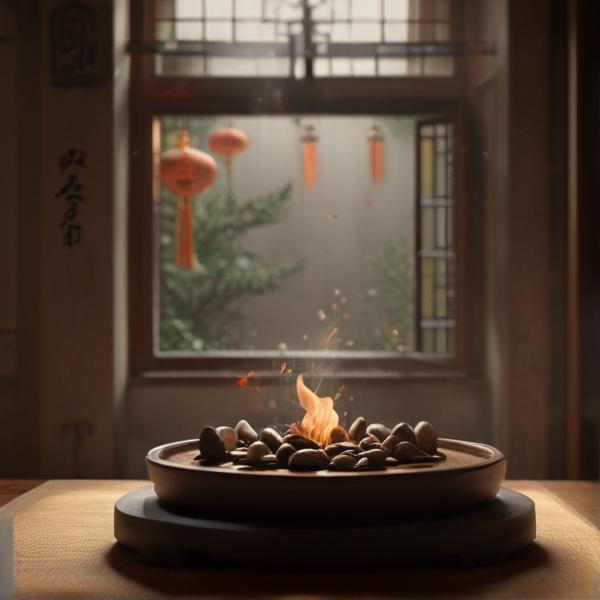基本信息 (Basic Information)
含义与用法 (Meanings & Usage)
中文核心释义 (Core Chinese Meaning): 用木材等在缺氧条件下烧制而成的黑色可燃固体,用作燃料,如木炭、煤炭。
英文核心释义 (Core English Meaning): charcoal; carbonized fuel made by burning wood or coal with limited oxygen.
象形意义 / 为何这么写 (Pictographic Meaning / Writing Rationale)
文言文释义 (Classical Chinese Meaning)
与现代意义相近,主要指燃烧后剩下的可燃黑色物质,如木炭。Similar to modern meaning; mainly refers to the combustible black residue remaining after burning, such as charcoal.
深入学习 (In-depth Study)
字源故事 (Origin Story)
字形演变 (Character Evolution)
常用词语和例句 (Common Words & Examples)
木炭 (wood charcoal)
农民用木炭做饭取暖。
Eng: Farmers use wood charcoal for cooking and heating.
活性炭 (activated carbon)
活性炭常用来净化水和空气。
Eng: Activated carbon is often used to purify water and air.
炭笔 (charcoal pencil (for drawing))
她用炭笔画了一幅素描。
Eng: She used a charcoal pencil to draw a sketch.
相关成语 (Related Idioms)
相关成语信息待补充。Related idiom information pending.
多语言翻译 (核心释义) (Translations (Core Meaning))
- French: charbon (de bois), charbon
- German: Holzkohle; Kohle
- Spanish: carbón (vegetal)
- Italian: carbone (vegetale)
- Portuguese: carvão (vegetal)
- Russian: древесный уголь; уголь
- Arabic: فحم (خشبي)
- Persian: زغال چوب
- Dutch: houtskool; steenkool
- Polish: węgiel drzewny
- Vietnamese: than củi; than
- Ukrainian: деревне вугілля; вугілля
视频学习资源 (Video Learning Resources)
通过以下链接在热门视频网站搜索 "炭" 的更多讲解:
Search for more explanations of "炭" on popular video sites:
- 在 Bilibili.com 搜索 "炭 字源 说文解字" (Search on Bilibili)
- 在 YouTube.com 搜索 "炭 character origin etymology" (Search on YouTube)
网络参考 (Web References for "炭") ()
网络内容摘要 (Web Content Summary):
```html炭的核心含义是指“木材等物经过火烧后未完全燃尽,所剩下的黑色多孔固体”,通常称为“木炭”。 Tan (炭) primarily means "charcoal," referring to the black, porous solid left after wood or other materials are not completely burned.
“炭”字形左边为“火”字旁,表示与火有关,右边省略了“山”和“干”的‘岸’作声旁,表明其发音。 The character combines the "fire" radical on the left (indicating its relation to fire) and a simplified "an" (岸) phonetic component on the right.
- 常用词:如木炭(charcoal)、活性炭(activated carbon)、炭笔(charcoal pencil)、炭黑(carbon black)。 Common words: such as 木炭 (mù tàn, charcoal), 活性炭 (huó xìng tàn, activated carbon), 炭笔 (tàn bǐ, charcoal pencil), 炭黑 (tàn hēi, carbon black).
注意“炭”与“碳”不同,后者指元素carbon,在科学中常用。 Note: "炭" (charcoal) is different from "碳" (carbon), which refers specifically to the chemical element and is used in scientific contexts.
有趣点:《说文解字》中解释为“烧木余也”,即“火烧剩余的木头”。 Cultural note: In the ancient dictionary Shuowen Jiezi, it is explained as "what remains after burning wood."
```【炭】的甲骨文金文篆文字形演变含义 - 甲骨文研究网
字形采用"火"作边旁,以省略了"山"和"干"的"岸"为声旁。 文言文名句摘抄 ①名词:由大量木材不彻底燃烧形制成的黑色多孔碳固体。 炭棒 炭笔 炭精 炭画 炭黑 炭炉 炭窑 炭薪 炭渣 / 草炭 骨炭 木炭 烧炭 活性炭 炭,烧木余也。 ------《说文》 火所烧余木曰炭。
汉字"碳"的起源、演变过程-汉字字源辞典
汉字字源辞典收录7747条汉字词条,基本涵盖了常见汉字的字源解析,是汉字研究的必备工具。
更多图片 (炭 More Images) ()
